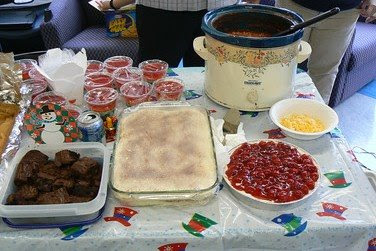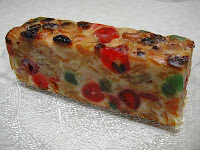I feel a little bit like Maria Von Trapp because I’m going to write about a few of my favorite (and least favorite) things. That is, what I like and I don’t like to eat and drink around the Christmas holiday. The opinions expressed here are solely those of the author and any similarity to conventional wisdom is purely coincidental.
Winners
1.
Standing Rib Roast. I can’t imagine having anything else for Christmas dinner; nothing is more magnificent or delicious. I know a lot of people like to have the ribs removed from their roast but don’t. Sure, it will make it easier to carve but the ribs form a natural cooking rack, lend flavor to the meat and make for a spectacular presentation. The only downside is expense, and because of the waste (bone and fat), you’ll need to figure about a pound per person. Personally, I like my rib roast sliced into neat, relatively thin slices—sometime called an English cut—rather than big slabs as it’s most often served in American restaurants. Everything you need to know about cooking perfect roast beef the first time and every time can be found in
Julia Child & Company (Alfred A. Knopf, 1978). The only other thing you’ll need is a good instant-read or digital meat thermometer.
2.
Yorkshire Pudding. It’s the perfect side with roast beef since it soaks up all the juices. This beloved English specialty is similar to an American popover but flavored with the drippings from the beef. Traditionally it’s baked in the roasting pan but some prefer using individual round molds. It couldn’t be easier to whip up ahead of time and bakes while the roast sits. The secret is to blend the batter in a blender or food processor, let it stand for 30 minutes or so, and then pour the batter into a hot pan: it will rise dramatically, be crispy brown on the outside and moist on the inside with a hollow center. A contemporary variation of sorts is a savory bread pudding like
Emeril Lagasse’s Exotic Mushroom Bread Pudding, a personal favorite.

3.
Country Ham. If you don’t already know what it is, forget all your preconceived notions about ham. Country ham’s only similarity to that wet, pink stuff they sell at the grocery store is both start out as a hog. These hams are dry cured, sometime smoked and then hung to age for one to two years. The end product is akin to prosciutto. A difference is that prosciutto is served raw. Country ham is soaked, then boiled and/or baked, trimmed of skin and fat and finally glazed or covered in bread crumbs. Like prosciutto, country ham is served sliced paper thin, either chilled or at room temperature. These types of hams are made throughout the southern states with various nuances in taste depending on the breed of the pig, what it is fed and how it is cured. Virginia and Kentucky are probably best known for their country hams. By the 1960s the making of this American specialty had become almost a lost art because of the time, labor and expertise involved. Discovered by some of the country’s best chefs, there is now a renaissance of production. Whole ham’s are expensive and a lot of work to prepare. If you do decide to try your hand, they nearly always come with good directions for preparation. If you’ve never tried country ham before, I would suggest you start by ordering some already cooked and sliced ham. My favorite country ham comes from
Finchville Farms in Finchville, Kentucky. They offer an extensive selection of quality country ham and ham products for sale on their website and shipped to your door.
4.
Roast Goose. I know … you’re expecting a Christmas goose joke … but seriously, it’s delicious and something different. It’s the Christmas dinner entrée of choice among Europeans and they’re no slackers when it comes to appreciating good food. If you’ve never cooked a goose before and try to cook it as you would a turkey or roasting chicken, the end result will be tough and greasy. The secret is to add liquid, or in other words, technically braise the goose rather than roast it. The result will be an attractive crispy skin with juicy and succulent dark meat. Julia Childs outlines the basic technique in
The Way to Cook (Alfred A. Knopf, 1989). Almost as good as the goose is potatoes cooked in its fat.
5.
Plum Pudding. Today this dessert conjures up images of Ye Olde England and Dickens’s A Christmas Carol. Plum pudding was once popular in this country, before the advent of reliable ovens and home baking since it was steamed on top of the stove. Actually, in England it’s usually called “Christmas pudding” and is an indispensable part of celebrating the holiday. It’s easy to make but takes a long time to cook—about 8 hours—and really needs to be made months in advance so it can mellow, regularly doused with a heavy pour of good spirits. Brought to the table flamed with cognac or rum, all round and rolly-poly and topped with its traditional decoration of a sprig of holly, it epitomizes everything that is magic about Christmas. “God bless us everyone!”
6.
Scottish Smoked Salmon. Forget about lox and that stuff they sell at the supermarket, this is the real deal. The secret is cold smoking at about 80 degrees which does not cook the fish, resulting in a delicate texture and buttery taste. (In Great Britain, salmon and other fish that are smoked by the more conventional hot fire method are referred to as “kippered”). In all fairness, similar excellent smoked salmon is also produced by the same technique in Ireland and Norway. It can be difficult to find authentic Scottish smoked salmon but you can
order it, shipped by air.
7.
Champagne. It’s not just for New Years any more. Besides, I’m just looking for an excuse to bring out the bubbly. Cheers!
8.
Rosettes. Think Norwegian food and I think lutefisk and lefsa and I say ‘No
thanks.’ But rosettes are dispensation for any of the country’s culinary sins. More a pastry than a cookie this fried and sugared confection is ethereally intoxicating. They do require some special equipment to make: a rosette iron (available at
Orange Tree Imports on Monroe Street) and a deep fryer. A fall back is Schubert's Cafe Bakery, 128 E. Main Street in Mount Horeb.
9.
Tamales. My first encounter with this Mexican Christmas Eve tradition was in San Diego. I love homemade tamales and good ones can be hard to come by in this neck of the woods. They are easy to make and my favorite filling is a
combination of pork and potatoes served with salsa verde.

10.
Artillery Punch. I’ve made it but never tasted it; therein is the attraction ... and it’s such a wonderfully bizarre potion. It comes to mind each holiday season because in the 1950s when I was in the 3rd grade my parents mixed up a big batch in a wash tub in the basement—and I helped. (It would be the highlight of their Pink and Chartreuse Christmas Party that year.) Unfortunately, I went to school and during show and tell shared both the recipe and how I got to stir in the gin—unfortunately, since my teacher was a teetotaler and henceforth branded me a delinquent and my parents degenerate. Fortunately, we moved out of state shortly thereafter. Recipe follows.
Losers1.
Eggnog. If the raw eggs won’t kill you, the fat and cholesterol will. I’d rather eat my dessert than drink it any day. Most of all, eggnog is a waste of good liquor—leave it out and it’s insipid … and, all that nutmeg? Nutmeg poisoning can cause disorientation, a sense of impending doom and hyperactivity.
2.
Candy Canes. They're okay as Christmas decorations but lousy candy. For anyone beyond the age of 10, peppermint is only suited as a flavor for toothpaste or mouthwash. Not to mention, after a kid has sucked on one of these things all day, it’s got a point sharp enough to poke your eye out.
3.
Pumpkin Pie. I love pumpkin pie … at Thanksgiving. Less homespun and more bling is the order of the day for Christmas.

4.
Buffets. Contrary to popular belief the word is not French for “all you can eat”. In France a buffet a can be a place where you purchase food of dubious quality. The difference between a buffet and a potluck is you not only have to serve yourself but furnish some of the food as well. I have to be honest: I never liked either but least of all at this time of year. I cannot pinpoint exactly when this hatred began. For some reason they always take me back to grade school, standing in line in front of a dour faced woman wearing a hairnet who is about to slop a large dollop of cream-style corn into my compartmentalized plate. A cocktail party is just dandy for grazing … picking and choosing tidbits from a big spread. Dinner, however, should have a coordinated menu; be served in courses; eaten seated in a chair at a table.
5.
Fruit Cake. I actually like
real fruit cake but it has to be homemade from quality ingredients

and allowed to mellow for many months, regularly slathered with lots of top shelf booze. What you’re more likely to get is the deserved brunt of so many jokes: dried out pound cake full of colorful candied fruit that tastes like a cut-up garden hose. I have a friend who has been using a fruit cake as a doorstop ever since I can remember.
6.
Christmas Cookies. As good as they can be in their own right, so many of so many different kinds arriving a time of year already saturated with glut is overkill. You can’t avoid them. They show up at work, at parties and as gifts from well-intentioned neighbors and friends. Plain or fancy, cut out in cute shapes or dropped as mysterious blobs, drenched in powdered sugar or sprinkled with dragees (those little silver and gold balls that break your teeth), the worse are those that have been stored together in the same container so that they all taste like tutti frutti.

7.
Disposable Tableware. Granted you can’t eat them but a lot of stuff you do this time of year is served on or in disposables. Why not just dispose of them all together? Even before it was environmentally responsible, I have always loathed paper plates, plastic cutlery and acrylic “glassware.” Not only are they aesthetically insulting—even mores so adorned with snowmen and reindeers—they make everything taste worse. Furthermore, it’s a sure bet that anyone who cuts corners in the dining room will do the same in the kitchen. I don’t expect my argument to gain much traction, but my hat goes off to Al Gore!
8.
White Zinfandel. Driving or not, friends don’t let friends drink this plonk. It’s been my experience, that those that fancy it would just as soon have pink lemonade anyway. For some reason this wine shows up a lot around the holidays, perhaps because of its merry rose hue but I think more likely the consequence of a re-gift.
9.
Christmas Tree Peeps. Okay, the silly little yellow marshmallow chickens that have been around at Easter since who knows when are kind of cool just because they are so tacky. Capitalizing on their kitschy popularity by concocting a version for Christmas (and Halloween and every other holiday) is blatant commercialism at it crassest. Besides, what are you suppose to do with them? Put them in your Christmas basket?
10.
Green Bean Casserole. Comfort food? Nursery food? I don’t th

ink so. From the start this recipe was a devious conspiracy by corporate food giant Campbell’s to sell more of their products. I mean, really, who ever bought those canned French fried onion rings before? With no apologies to Paula Dean, any recipe that begins with “add a couple of cans of condensed soup,” is not for me, least of all to celebrate a special occasion.
1954 Artillery Punch6 cups strong black tea
1 liter bourbon
1 750-ml bottle cabernet sauvignon
3 cups dark Jamaican rum
1½ cups gin
1½ cups brandy
3 ounces Benedictine
3 cups freshly squeezed orange juice
1½ cups freshly squeezed lemon juice
½ cup grenadine
Mix all the ingredients and let stand 2 hours or more to mellow. Pour over a block of ice in a large punch bowl.
Serves 12.
 After the holidays, I crave food not so fuzzy but it’s still winter and I want something hearty … preferably something that will perk up my jaded palate. ‘Tis the season for soup. Lots of places make a good soup of the day to be sure—both Café Soleil and Marigold Kitchen immediately come to mine—but sometime I’m not in the mood to take potluck … certainly not up for a bowl of cream of tomato. Fortunately, there are restaurants in Madison that have soup specialties of the house—so good they’re on the menu every day or at least on a regular basis. Here are my top 10, Best of Madison Soups.
After the holidays, I crave food not so fuzzy but it’s still winter and I want something hearty … preferably something that will perk up my jaded palate. ‘Tis the season for soup. Lots of places make a good soup of the day to be sure—both Café Soleil and Marigold Kitchen immediately come to mine—but sometime I’m not in the mood to take potluck … certainly not up for a bowl of cream of tomato. Fortunately, there are restaurants in Madison that have soup specialties of the house—so good they’re on the menu every day or at least on a regular basis. Here are my top 10, Best of Madison Soups.

 The Old Fashioned: Green Bay Chili
The Old Fashioned: Green Bay Chili




 4. Buffets. Contrary to popular belief the word is not French for “all you can eat”. In France a buffet a can be a place where you purchase food of dubious quality. The difference between a buffet and a potluck is you not only have to serve yourself but furnish some of the food as well. I have to be honest: I never liked either but least of all at this time of year. I cannot pinpoint exactly when this hatred began. For some reason they always take me back to grade school, standing in line in front of a dour faced woman wearing a hairnet who is about to slop a large dollop of cream-style corn into my compartmentalized plate. A cocktail party is just dandy for grazing … picking and choosing tidbits from a big spread. Dinner, however, should have a coordinated menu; be served in courses; eaten seated in a chair at a table.
4. Buffets. Contrary to popular belief the word is not French for “all you can eat”. In France a buffet a can be a place where you purchase food of dubious quality. The difference between a buffet and a potluck is you not only have to serve yourself but furnish some of the food as well. I have to be honest: I never liked either but least of all at this time of year. I cannot pinpoint exactly when this hatred began. For some reason they always take me back to grade school, standing in line in front of a dour faced woman wearing a hairnet who is about to slop a large dollop of cream-style corn into my compartmentalized plate. A cocktail party is just dandy for grazing … picking and choosing tidbits from a big spread. Dinner, however, should have a coordinated menu; be served in courses; eaten seated in a chair at a table.











